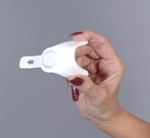
A prospective clinical study of fourty-eight (48) women undergoing breast augmentation was conducted from November 2007 to November 2008. Women underwent breast augmentation with either saline or silicone breast implants through a transaxillary (saline) or inframammary (silicone) incision. Patients were aware that they would receive Actipatch therapy as part of their postoperative protocol. At the completion of surgery, Actipatch devices (crescent-shaped) were placed over the medial and superior aspect of the breasts (over the pectoralis muscle) and taped into position inside their surgical bra. For the first twenty patients, the device was activated (activating tab pulled) on the left breast and on the opposite right breast the device was not activated. (activating tab was trimmed but not pulled) The patients were not informed which devices were which. In the next twenty-eight patients, the device locations were reversed. Patients were instructed to wear the devices for the first seventy-two hours after surgery after which they were to be discarded. Patients were given a sheet to complete at the time of discontinuing their ActiPatch therapy so that they could rate their postoperative pain on a simple scale (1 – 10) and, most importantly, compare and rate the pain between the two breasts at that time period.
In the first twenty patients, fourteen rated the active device breast as less uncomfortable than the control patch side. In the next twenty-eight patients, twenty-one rated the active side less painful. In total, thirty-five patients (73%) reported less pain and uncomfortability on the breast that received pulsed electromagnetic therapy than on the control side.
Pulsed electromagnetic therapy has been around for a long time and its potential benefits are based on creating an anti-inflammatory effect. Actipatch provides a simple, low-cost method of delivery of this potential healing technology. In this breast augmentation study, Actipatch demonstrated less pain within the first few days after surgery. Given its ease of use and lack of any potential for creating any adverse problems, its use as part of a breast augmentation recovery protocol appears to have offer patients some real benefits.
While all pain studies are flawed, and this one is no exception, it certainly suggests that pulsed electromagnetic therapy (PEMT)should be further explored. A change in the design of the device so that it ‘fits’ the breast better may be even more useful. A large round loop that would fit around the circumference of the breast is more likely to deliver the effects of PEMT to the breast in a more even distribution although I could argue that the pain after breast augmentation is muscular rather than ‘breast’ in origin.
Dr. Barry Eppley
Indianapolis, Indiana


